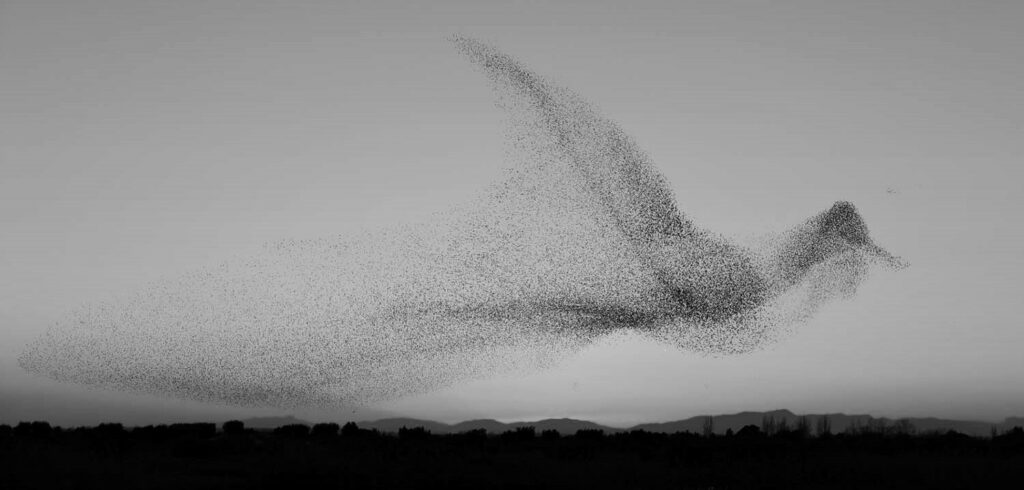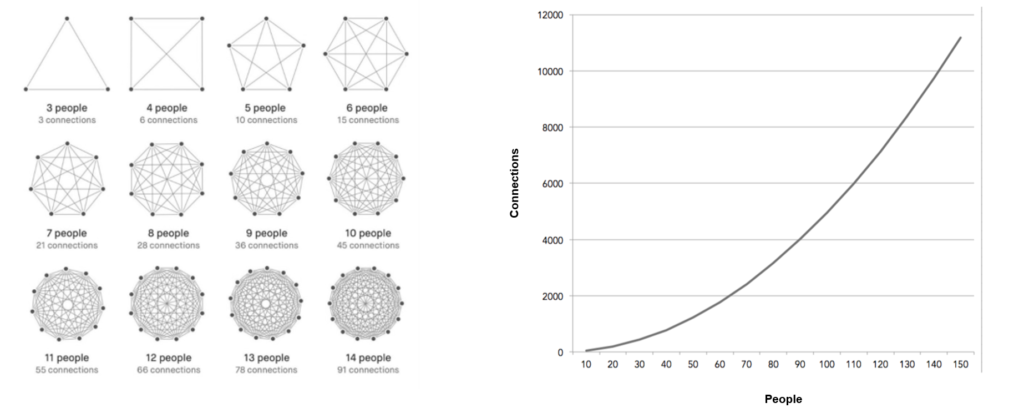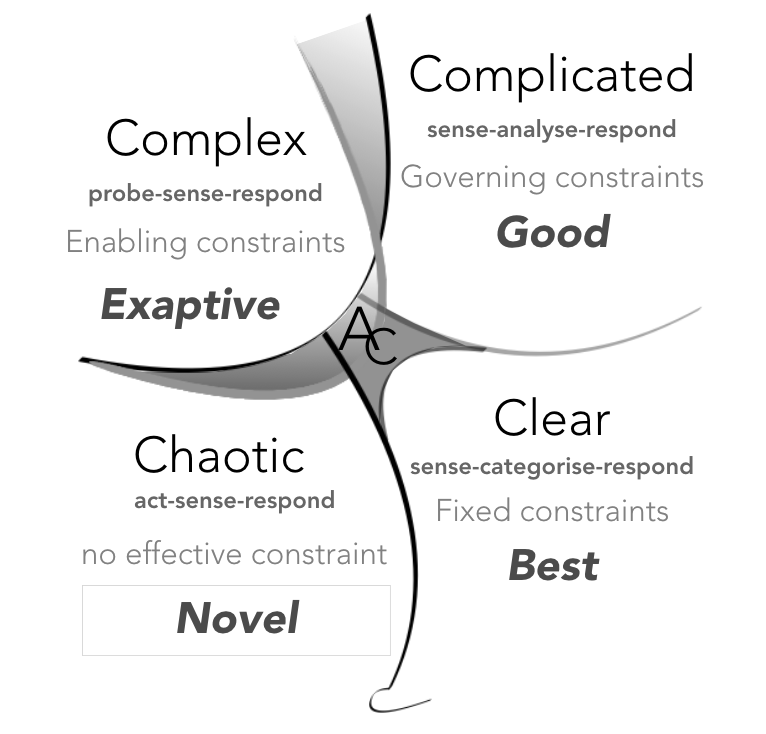There’s no shortage of “how to” advice, playbooks, formulas and even secrets and guarantees for business success (at least that’s what the gurus will have you believe). This can work well in complicated situations. But high-growth technology businesses are not complicated, they’re complex. That requires a different approach to growing and leading a business, explored here through the lens of the Cynefin framework.

Follow the links below to jump to a section:
- The difference between complicated & complex
- Cynefin: a sensemaking framework for leaders
- Mistaking complex challenges for complicated ones
- Using Cynefin to understand leadership “at a different level”
The difference between complicated & complex
Let’s start with the important differences between things that are complicated and complex:
Being complex is different from being complicated. Things that are complicated may have many parts, but those parts are joined, one to the next, in relatively simple ways: one cog turns, causing the next one to turn as well, and so on, the workings of a complicated device like an internal combustion engine might be confusing, but they ultimately can be broken down into a series of neat and tidy deterministic relationships; by the end, you will be able to predict with relative certainty what will happen when one part of the device is activated or altered. Complexity, on the other hand, occurs when the number of interactions between components increases dramatically – the interdependencies that allow viruses and bank runs to spread; this is where things quickly become unpredictable.
Team of Teams: New Rules for Engagement in a Complex World (Amazon UK, US)
In a complicated context, at least one right answer exists. In a complex context, however, right answers can’t be ferreted out. It’s like the difference between, say, a Ferrari and the Brazilian rainforest. Ferraris are complicated machines, but an expert mechanic can take one apart and reassemble it without changing a thing. The car is static, and the whole is the sum of its parts. The rainforest, on the other hand, is in constant flux—a species becomes extinct, weather patterns change, an agricultural project reroutes a water source—and the whole is far more than the sum of its parts.
This is the realm of “unknown unknowns,” and it is the domain to which much of contemporary business has shifted.
A Leader’s Framework for Decision Making
Rainforests, unlike combustion engines and Ferarris, are an example of a complex adaptive system.
All complex adaptive systems share common characteristics, irrespective of whether the complex adaptive system is the economy, the internet, an ant colony or the brain. First of all the system is complex, it contains many diverse and specialized agents, components or parts (>3) in an intricate arrangement. Second, it is adaptive, it has the capacity to change under influence of feedback or memory (learn from experience) and thus evolve, giving it resilience in the face of perturbation. CAS are usually open systems, a system which continuously interacts with its environment. This permits feedback. Complex Adaptive Systems have a history or memory: they evolve and their past is co-responsible for their present behavior.
Complex Adaptive Systems
What’s important to understand is that businesses, including startups and high growth technology businesses, and the competitive ecosystem within which they operate, are complex adaptive systems, not complicated systems. This requires a different approach and mindset to business building and leadership, and that’s where Cynefin can help.
Cynefin: a sensemaking framework for leaders
Cynefin is a Welsh word meaning “places or habitats of multiple belonging”. It’s a sensemaking tool. It signifies the multiple factors in our environment and our experience that influence us in ways we can never understand, but it isn’t prescriptive, like a playbook or formula. Let’s explore its relevance to the frenetic world of startups and high growth businesses.
Clear (previously known as Simple and Obvious) Contexts: The Domain of Best Practice
[Clear] contexts are characterized by stability and clear cause-and-effect relationships that are easily discernible by everyone. Often, the right answer is self-evident and undisputed. In this realm of “known knowns,” decisions are unquestioned because all parties share an understanding. Areas that are little subject to change, such as problems with order processing and fulfillment, usually belong here. [Clear] contexts, properly assessed, require straightforward management and monitoring. Here, leaders sense, categorize, and respond. That is, they assess the facts of the situation, categorize them, and then base their response on established practice.
A Leader’s Framework for Decision Making
Cynefin highlights the difference between those things that live in a predictable world (where patterns are straightforward enough to repeat time after time) and those things that live in an unpredictable world (where patterns are emergent and are created by such a wide variety of interacting forces that you can’t ever be sure that just because certain factors led to a particular outcome in one case, they will necessarily lead to the same outcome in the future). In the predictable world, Snowden describes two different domains. Things are [Clear] if the connection between cause and effect is repeatable and obvious to all. Implementation is a technical issue and people should readily agree on both the desired outcome and the desired pathway to get there.
Coaching for an Increasingly Complex World
Payroll systems sit in the Clear category. To paraphrase the article above, managers should know exactly what to do to make sure that people are paid what they have agreed to be paid. HR and Health & Safety procedures also sit in this category. There are specific protocols to observe and follow, in order to comply with statutory laws. In the Clear domain, best practice can be researched and then replicated – all it takes is to notice the problem and then plug in the appropriate solution.
Complicated Contexts: The Domain of Experts
Complicated contexts, unlike simple ones, may contain multiple right answers, and though there is a clear relationship between cause and effect, not everyone can see it. This is the realm of “known unknowns.” While leaders in a simple context must sense, categorize, and respond to a situation, those in a complicated context must sense, analyze, and respond. This approach is not easy and often requires expertise: A motorist may know that something is wrong with his car because the engine is knocking, but he has to take it to a mechanic to diagnose the problem.
A Leader’s Framework for Decision Making
In the Complicated domain, there’s a predictable and repeatable connection between the cause and the effect, but there’s enough of a lag or enough different steps that you need experts to help figure things out. Different experts might disagree on exactly the right path (so you have to choose the ones you trust or the ones who have a good track record), but all of them should agree on the best outcome.
Coaching for an Increasingly Complex World
Completing your annual accounts and claiming your R&D tax credits falls into this category: “ask two accountants to look at your books and you might get slightly different deductions or categorizations, but you’d expect that all of them would mostly focus on the financials, and all of them would share the goal of keeping you out of trouble with the tax authority. If they were paying attention to really different things, you might worry”.
Sales is also largely complicated. Although obviously vital for any high growth business, once you’ve experimented with your sales strategy (complex) and got your flywheel spinning, execution becomes a complicated process of managing a team to follow a largely predefined process.
Complex Contexts: The Domain of Emergence
Here things start to get interesting. The complicated domain is usually their home base but much of what leaders are required to do is complex. This is Snowden’s realm of “unknown unknowns”. Things are unpredictable in Cynefin’s Complex domain, so the rules must change:
Business models and business strategy are complex. Just about everything to do with people and change – culture change, employee engagement, innovation, etc. – is complex. It’s not that everything leaders need to do is complex – lots of important work gets done in the Clear and Complicated spaces – but every leader has key portions of her work that are complex.
In the Complex domain, there are too many interacting forces to know what is going to happen next. Instead, we can only infer the cause after we see the effect. Much research has been done into complex events to try to find the right answers that will help us predict the next time. We look at a company that has failed and try to understand the warning signs so that it will definitely not happen to us; we look at a company that has done really well and we try to backfill our understanding of why it has been so successful. This can lead to really interesting findings and helpful approaches, but we have to be careful to not slip into believing that simply because those things worked in the past, they will continue to work into the future in just this way. There are too many moving parts – too many people with opinions and abilities of their own or too many contextual forces that interact to create new patterns. Here, because you cannot know how something will turn out until afterwards, it’s vital to pay attention to the patterns rather than attempt to predict the future.
Coaching for an Increasingly Complex World
Mistaking complex challenges for complicated ones
Expert advice is the domain of Clear and Complicated domains. Telling a leader what to do, dispensing “how to” advice, and helping them solve their challenges with playbooks and formulas is helpful in a complicated environment. It’s both necessary and helpful at the beginning of their journey. It will get enough businesses through to the next growth stage – on the basis that startup survival rates are Darwinian in nature and venture capital returns follow a Power Law. That’s why investors and advisors are so keen to give it, and new leaders are so keen to receive it.
It’s not to say that expert advice can’t still be helpful in complex scenarios, it’s just that we must be very careful what we do with it. One of the biggest dangers of “how to” advice is the illusion that it is correct. It assumes the answer is known with foresight, yet in complexity, the answer only reveals itself in hindsight. Even the world’s foremost experts on any particular topic simply cannot know the outcome with certainty (think about how countries responded to the Coronavirus pandemic) even if they think they do. And remember:
Any advice comes with nuance that’s rarely discussed… Advice is always highly context dependent and just because a particular strategy, tactic, or other course of action led to success in the past, doesn’t mean that it was the only reason for previous success, that it will work again in the future, or that it accounts for luck, randomness or other features of the complex world we live in.
The best advice for entrepreneurs? Learn to think for yourself
Technology, complexity and emergence
The most important characteristic of complex adaptive systems is that they show emergence: the whole is more than the sum of the components and the very specific connectivity creates a new property. Complex adaptive systems are self-organizing, that is, the complexity of the system, and thus emergence, increases without an external organizer but by making the components competitive. This results in nonlinear behaviour: small causes can have large results, also known as the butterfly effect. Thus anything can emerge, depending on the feedback, and if you wait long enough it will happen. The emergence arises once a lever or tipping point has been reached.
Complex Adaptive Systems

You’re probably familiar with the idea that technology businesses grow in a non-linear, or exponential, manner. Emergence is a function of that growth trajectory. That is to say that as a technology business grows (often infused by the ‘rocket fuel’ of venture capital or other external investment) the system itself does not just increase in size, but it actually changes in novel and unpredictable ways. “The whole is greater than the sum of its parts” is a simpler way of capturing the key aspects of this idea.
A more nuanced definition is higher-order complexity arising out of chaos in which novel, coherent structures coalesce through interactions among the diverse entities of a system. Emergence occurs when these interactions disrupt, causing the system to differentiate and ultimately coalesce into something novel. Key elements of this definition are chaos and novelty. Chaos is random interactions among different entities in a given context.
What Is Emergence?
Emergent growth does not just impact hard metrics (revenues, market penetration etc) but also people and culture. This raises important questions for a leader relating to not just strategy and business models, but also your rapidly expanding team. Whilst Metcalfe’s Law is more commonly associated with the Network Effects that have spurred the non-linear growth of businesses like Facebook and Uber, it can also be applied to teams.

A business that has raised £1 million is a very different place from one that has raised £10 million, which is a very different place from a business that has raised £100 million. In the same way, a business with 10 team members is very different from a team with 50 members, which is very different from a team with 150 members (reaching Dunbar’s Number ushers in a whole new world of complexity).
Across all aspects of your business, how do you manage rapid, non-linear growth, the emergent properties of which mean that you have far less control over than you actually think?
Using Cynefin to understand leadership “at a different level”
This is what’s wrong with most of the business literature as they try to put it into some framework like here are the three steps you need to go Good to Great, be a Built to Last , or whatever Jim Collins says. Because it’s not like… it’s very situational. It’s very specific to your company and your product and your market and your people and all these kinds of things. The things that you are doing, you have to understand it at a different level [emphasis added]. There’s not the ABCs of building a company. You can follow the 30 steps of building a company that anybody puts out and get nowhere all the time.
Ben Horowitz, on the Masters in Business podcast
Complex is the default state of modern business and leadership*. To increase the chances of success, modern leaders need to not just understand complexity, but be able to thrive within it. As tech leaders advance through funding rounds, formulaic advice becomes not just unhelpful – because the environment has become increasingly complex – but also a hindrance. Feeding leaders a constant diet of advice, playbooks and formulas creates both a reliance on ongoing expert input but, more importantly, constrains their capacity to adapt to a complex environment in a way that they will need to do if they are to ever reach real scale.
* Cynefin identifies a fourth domain – Chaos
In a chaotic context, searching for right answers would be pointless: The relationships between cause and effect are impossible to determine because they shift constantly and no manageable patterns exist—only turbulence. This is the realm of unknowables. The events of September 11, 2001, fall into this category. In the chaotic domain, a leader’s immediate job is not to discover patterns but to staunch the bleeding. A leader must first act to establish order, then sense where stability is present and from where it is absent, and then respond by working to transform the situation from chaos to complexity, where the identification of emerging patterns can both help prevent future crises and discern new opportunities. Communication of the most direct top-down or broadcast kind is imperative; there’s simply no time to ask for input.
Whilst things often feel chaotic in startup and high growth businesses, they’re actually complex, most of the time. Sometimes they may tip into chaos (e.g. after a failed product launch, or data breach).
I’m Richard Hughes-Jones, an Executive Coach to CEOs and senior technology leaders.
My clients are transitional founders, CEOs and executives in high-growth technology businesses, the investment industry and progressive corporates.
Having often already mastered the technical aspects of their craft, I help my clients navigate the complex adaptive challenges associated with executive-level leadership and growth.
I’m based in London and coach internationally. Find out more about my Executive Coaching services and get in touch if you’d like to explore working together.



